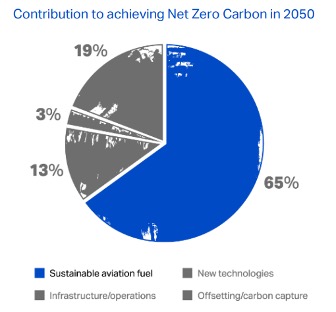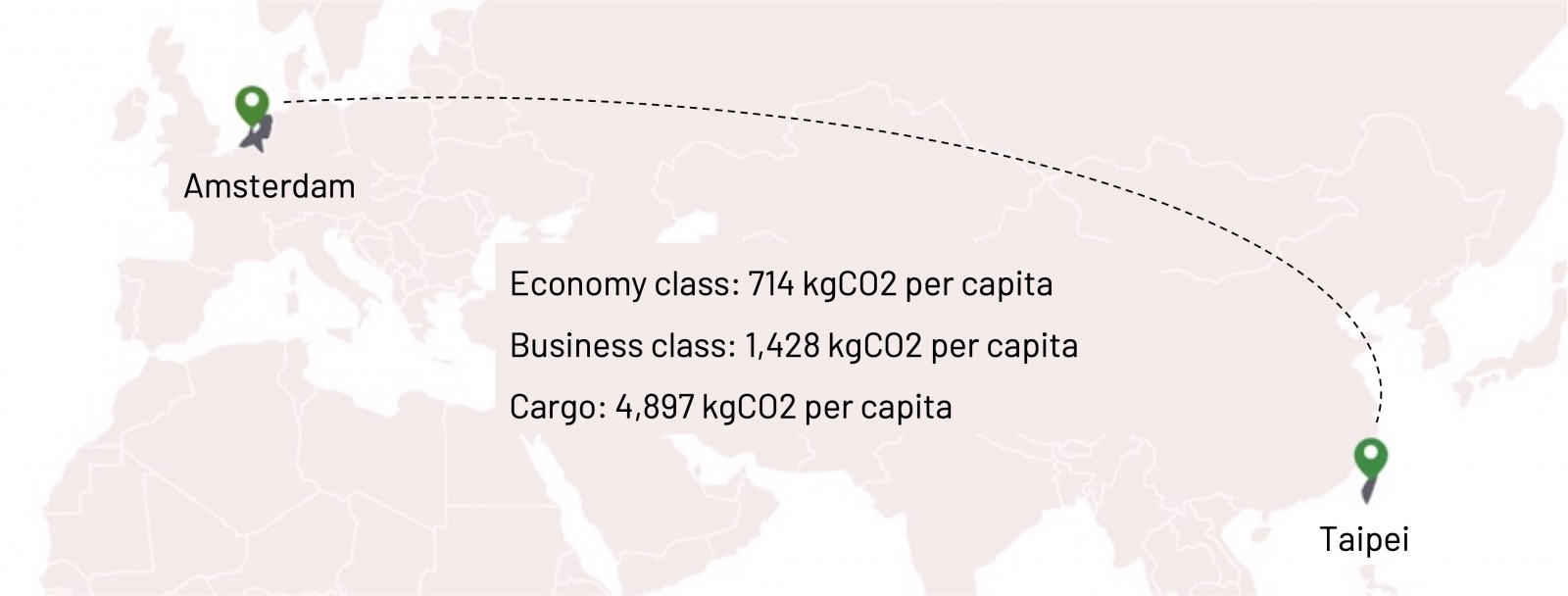Global emissions from the aviation sector
Aviation accounts for about 2.5% of global carbon emissions and 12% of those from the transportation sector. Before the outbreak of the COVID-19 pandemic, the International Civil Aviation Organization (ICAO) projected that by 2050, carbon emissions from international aviation could double what they were in 2015. Not only carbon dioxide, the release of nitrogen oxides, water vapor, sulfates, and particulates from flights passing through high altitudes could also have a significant impact on the climate.
Carbon Offsetting and Reduction Scheme for International Aviation (CORSIA)
The Carbon Offsetting and Reduction Scheme for International Aviation (CORSIA) is a global initiative established by the International Civil Aviation Organization (ICAO) to mitigate the environmental impact of international aviation by implementing carbon offsetting measures. Since its inception in 2021, 121 countries have voluntarily participated in the scheme as of May 2023. It uses the average emissions of each airline from 2019 to 2020 as a baseline and requires participants to purchase voluntary carbon offsets or engage in emissions reduction missions based on the growth of their international air transport each year thereafter to offset emissions beyond the 2020 level.
According to CORSIA, airlines will be required to:
- Monitor emissions from all international flights.
- Offset emissions from specified flights by purchasing carbon credits generated from other emissions reduction projects, such as renewable energy.
Implementation process of CORSIA
- Trial phase: 2021-2023, applicable to participating countries on a voluntary basis.
- Phase 1: 2024-2026, applicable to participating countries on a voluntary basis.
- Phase 2: 2027-2035, applicable to all countries whose individual share of Revenue Tonne Kilometers (RTK)[1] for international aviation activities in 2018 exceeds 0.5% of total RTK, or whose cumulative share from highest to lowest RTK amounts to 90% of total RTK, excluding Least Developed Countries (LDCs), Small Island Developing States (SIDS), and Landlocked Developing Countries (LLDCs), unless they voluntarily participate in this phase.
CORSIA aims to reduce 2.5 billion tonnes of carbon dioxide from 2021 to 2035. In terms of the aviation industry's overall emissions reduction target, the International Air Transport Association (IATA) introduced the Fly Net Zero initiative in 2021, with the goal of improving fuel efficiency of aviation fleets by 1.5%, reducing carbon emissions to half of the 2005 level and reaching net zero by 2050.
CORSIA-recognized entities
The ICAO has approved seven CORSIA-eligible emissions reduction verification units, of which only three are included in the Global Emissions Offset (GEO) futures contract.
(* Indicates GEO approval)
- American Carbon Registry (ACR)*
- Verified Carbon Standard (VCS)*
- Gold Standard (GS)
- Climate Action Reserve (CAR)*
- Clean Development Mechanism (CDM)
- China GHG Voluntary Emission Reduction Program (CCER)
- Architecture for REDD+ Transactions (ART)
[1] Refers to the load (or sales) capacity in metric tons of passenger and cargo multiplied by the flight distance. In other words, RTK levels correspond to the volume of air transportation activity. When an airline transports more passengers and cargo over longer distances, the operator's RTK level increases.
Passenger carbon offsetting program
This program is designed to provide global travelers with the option to offset the carbon dioxide generated during their flight. Passengers can calculate the amount of carbon dioxide produced during their trip based on class of travel, distance traveled, and number of companions, and choose to support CORSIA or other certified third-party emissions reduction projects by paying an equivalent or specified amount.
Sustainable aviation fuels
Sustainable aviation fuels (SAF) can help reduce carbon emissions from flights by up to 80%. Since SAF are made from waste feedstocks and oil, agricultural and forestry residues, and wet waste, the carbon dioxide emitted from using SAF is equivalent to the carbon dioxide originally present in these waste materials. Different from fossil fuels where carbon is stored in a liquid form before combustion, the use of SAF does not increase the concentration of carbon dioxide in the atmosphere.
According to IATA, if the aviation industry achieves the 2050 net zero goal, SAF would help reduce 65% of carbon emissions; new technologies, electricity, and hydrogen contribute 13%; while carbon capture and offsetting account for 19%, suggesting the indispensable role of SAF towards achieving carbon neutrality in the aviation industry. In 2022, the production of SAF tripled compared to 2021, reaching 300 million liters.

Source: IATA
Aviation emissions reduction measures in the U.S.
The U.S. government aims to reduce aviation carbon emissions by 20% by 2030 through a number of measures, including tax credits. If the GHG emissions produced during the life cycle of the fuel are reduced by over 50%, a tax credit of USD 2 per gallon will be granted. Aircraft covered by this rule account for 10% of the total GHG emissions from US transportation and about 3% of the country's total emissions.
Aviation emissions reduction measures in the EU
- To achieve carbon neutrality, the European Green Deal sets a target to reduce transport emissions by 90% by 2050 (compared to 1990 levels).
- Under the Fit for 55 package, most polluting fuels on routes within the EU would be taxed, with pure jet freighters excluded and non-commercial aircraft subject to a lower rate of tax. The package will be phased in from 2023, with full implementation in 2033 after a ten-year transition period.
- The European Commission plans to phase out free carbon allowances for airline operators to encourage companies to reduce carbon emissions or pay for pollution, while imposing an EU-wide aviation fuel levy to incentivize the use of low-carbon fuels.
- The European Parliament passed a regulation that, starting from 2025, requires 2% of aviation fuel to be derived from renewable sources, which will increase to 6% by 2030, 42% by 2040, and 50% by 2050. In addition, a certain proportion of fuel must be synthetic (1.2% by 2030, 2% by 2032, 5% by 2035, and gradually reaching 35% by 2050), such as green synthetic kerosene (e-kerosene).
- From 2025 onwards, flights meeting fuel efficiency standards will be awarded an eco-label, which can be used for marketing purposes and serves as a basis for passengers to choose flights.
- According to the EU Emissions Trading System (EU ETS), all airlines operating in Europe (whether European or non-European companies) must monitor, report, and verify their carbon emissions and surrender carbon allowances. In 2017, the EU amended the EU ETS aviation regulations to flights within the European Economic Area (EEA). However, the original scope will be restored from 2024 considering the development of CORSIA-related international programs.
Emission factors for flights
China Airlines

Source: China Airlines
- Passenger flight carbon footprint: Carbon footprint generated by traveling in economy and business class.
- Cargo carbon footprint: Carbon footprint generated by transporting one metric ton of goods.
Case study
United Airlines
- Aims to achieve carbon neutrality by 2050.
- Participates in the Carbon Disclosure Project (CDP) and is the first US airline to do so.
- Engages in the Eco-Skies CarbonChoice offset program, which offers customers and businesses a pathway to purchase carbon offsets, thereby reducing emissions from travel and cargo transport.
Carbon emissions calculation example (based on 2019 data)
- Scope 1: Includes jet fuels, SAF, vehicles, infrastructure, dry ice for catering, etc.
- Scope 2: Emissions from purchased electricity or other energy consumption.
- Scope 3: Fuel for regional jets, other company-owned assets, vehicles, etc.
Source
- United Airlines
- CME Group. Carbon convergence across the geo-sphere.
- Airport Technology. European Commission's aviation pollution tax proposal fuels debate.
- European Commission. Reducing emissions in aviation. Climate Action.
- European Parliament. Fit for 55: Parliament and Council reach deal on greener aviation fuels.
- International Air Transport Association (IATA). Fly Net Zero.